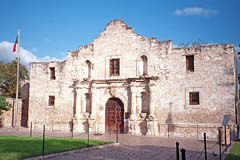|
On March 6, 1836, the men
inside the Alamo – many of them Irish – could hold out no longer.
Barricaded within a mission compound-turned-fort in San Antonio,
they’d held out for nearly two weeks against several thousand
Mexican soldiers under the command of Santa Anna. But with a
rising death toll, dwindling supplies, and no reinforcements, defeat
was only a matter of time. When Santa Anna’s men finally breached
the compound that day in early March, none inside were spared in the
most heralded battle in the struggle for Texas independence.
Before 1835, Texas was part of Mexico, which in turn had only
recently (1821) gained its independence from Spain. The government
of newly independent Mexico was wary of the expanding United States
to the north, but it also wanted to attract settlers – even if they
were Americans -- to its northern regions. So, beginning in the late
1820s, it offered contracts to any empressario who, in exchange for
as much as 40,000 acres of land, agreed to settle a certain number
of families in Mexican territory.
Stephen Austin was the first to arrive with the band of settlers
in 1821. Thousands more Americans soon followed, drawn by the
promise of land and opportunity. “What I have seen of Texas,” wrote
one enthusiastic pioneer by the name of Davy Crockett, “it is the
garden spot of the world.”
Among these Texas pioneers were many Irish. Indeed the Mexican
government was quite keen on Irish immigrants, reasoning their
Catholic faith would strengthen their loyalty to the Mexican
government.
Two notable Irish empressarios were James McGloin and John
McMullen who in 1828 received a large land grant for the settlement
of 200 families. The next year they brought Irish families from New
York, establishing the “Villa de San Patricio de Hibernia” (town of
St. Patrick of Ireland) on the Neuces River’s north bank. The town
became the county seat of San Patricio County, Texas after Texas
independence. In 1834, two more Irishmen, James Power and James
Heweston, likewise established a settlement named Refugio on the
Gulf of Mexico to which they brought dozens of families directly
from Ireland.
By the early 1830s, the more than 20,000 American settlers in
Texas easily outnumbered their Mexican counterparts. The Mexican
government passed laws to slow the tide of American immigration, but
to no avail. To make matters worse, few of these settlers exhibited
much affection for the Mexican government, especially after the
overbearing Gen. Antonio López de Santa Anna became President in
1833. Protest soon flourished into open rebellion and by late 1835
the war for Texas independence was on.
|

Enraged, Santa Anna led an army of 5,000 into Texas to subdue the American
rebellion. He headed straight for San Antonio, an old mission
settlement reportedly under rebel control.
The report was true. By mid February, a force of 187 men barricaded
in the old Alamo mission compound. Among them were nearly 40 men of
Irish heritage, beginning with two descendents of Ulster Irish
immigrants, the leader Col. William Barrett Travis and Davy Crockett.
At least a dozen, with names like Jackson, McGee, and Nolan, and
McCafferty, were Irish-born. The rest, including several from the
Refugio and San Patricio settlements, are believed to be either of Irish
or Irish American heritage.
The goal of Travis and his men was to hold the Alamo until
reinforcements arrived. Unfortunately, they never arrived. Santa Anna
laid siege to the Alamo on February 23. For thirteen days his men
poured a hail of bullets and cannon balls into the stubborn outpost.
Several times Santa Anna offered to spare their lives if they would
surrender, but they refused, choosing instead to fight to the death.
When the final assault succeeded on March 6, Santa Anna’s men were under
strict orders to execute all survivors.
Santa Anna’s victory at the Alamo was short-lived. For Sam Houston,
another man of Irish lineage, soon had the opportunity to avenge the
massacre at the Alamo and win Texas independence. In late April 1836,
Houston's force surprised Santa Anna’s army at San Jacinto and crushed
it. Texas independence, declared on March 2 during the siege of the
Alamo, was now a reality.
Today the Alamo is a shrine maintained by the Daughters of the
Republic of Texas. Every year on St. Patrick’s Day, members of the Harp
and Shamrock Society of Texas lay a wreath at the Alamo to honor the
memory of the Irish and Irish Americans who died in the struggle to win
Texas independence.
Text courtesy of
Edward T. O'Donnell.
|

